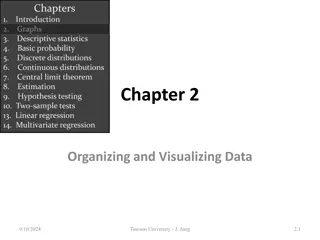Understanding Dentinogenesis: A Comprehensive Overview
Dentinogenesis is a crucial process in tooth development starting at the cusp tips as odontoblasts differentiate and begin collagen production. Factors like TGF, IGF, and BMP play key roles in organizing odontoblast cytoskeleton assembly. Odontoblasts take up calcium, maintain high concentrations, and induce mineralization with the help of matrix vesicles. This continuous process leads to crown formation, teeth eruption, and eventual occlusion. Radicular dentin formation differs from coronal dentin in speed and collagen fiber orientation. Mineralization involves crystal deposition of hydroxyapatite on collagen fibrils.
Download Presentation

Please find below an Image/Link to download the presentation.
The content on the website is provided AS IS for your information and personal use only. It may not be sold, licensed, or shared on other websites without obtaining consent from the author. Download presentation by click this link. If you encounter any issues during the download, it is possible that the publisher has removed the file from their server.
E N D
Presentation Transcript
Begins at the cusp tips after the odontoblasts have differentiated and begin collagen production. Dentinogenesis factors like TGF, IGF and BMP which are present in the inner enamel epithelium, are released and these are taken up by the preodontoblast. These factors help in the organization of odontoblast cytoskeleton assembly, which is important for relocation of organelles that occurs prior to morphological changes. As the odontoblasts differentiate they change from an ovoid to a columnar shape, and their nuclei become basally oriented at this early stage of development.
Odontoblast takes up the calcium and maintains its concentration higher than in tissue fluid. Matrix vesicles are involved in the mineralization of mantle dentin. The matrix vesicles, prior to its release by the odontoblast promotes the formation of apatite. It contains enzymes like alkaline phosphatase, which locally increases the concentration of phosphates and these combine with calcium taken up from the tissue fluid to form apatite within it closed in a tubule. As the matrix formation continues, the odontoblast process lengthens.
This continues until the crown is formed and the teeth erupt and move into occlusion. After root development is complete, dentin formation may decrease further, although reparative dentin may form at a rate of 4 m/day for several months after a tooth is restored. Dentinogenesis is a two-phase sequence in that collagen matrix is first formed and then calcified. As each increment of predentin is formed along the pulp border, it remains a day before it is calcified and the next increment of predentin forms. Korff s fibers have been described as the initial dentin deposition along the cusp tips.
The radicular dentin formation compared to coronal dentin, is slower, less mineralized with collagen fibers laid down parallel to the cementodentinal junction. These collagen fibers unlike in coronal dentin are laid adjacent to the non-collagenous matrix of (Hertwig s epithelial root sheath).
Mineralization The earliest crystal deposition is in the form of very fine plates of hydroxyapatite on the surfaces of the collagen fibrils and in the ground substance . Subsequently, crystals are laid down within the fibrils themselves. The crystals associated with the collagen fibrils are arranged in an orderly fashion, with their long axes paralleling the fibril long axes.
Within the globular islands of mineralization, crystal deposition appears to take place radially from common centers, in a so-called spherule form. These are seen as the first sites of calcification of dentin. The general calcification process is gradual, but the peritubular region becomes highly mineralized at a very early stage.
INNERVATION OF DENTIN Intratubular nerves Nerve fibers were shown to accompany 30 to 70% of the odontoblastic process and these are referred to as intratubular nerves (within). Dentinal tubules contain numerous nerve endings in the predentin and inner dentin. Most of these small vesiculated endings are located in tubules in the coronal zone, specifically in the pulp horns.
The nerves and their terminals are found in close association with the odontoblast process within the tubule. In any case, they interdigitate with the odontoblast process, indicating an intimate relationship to this cell. Synapse like relation between the process and nerve fibers were demonstrated. It is believed that most of these are terminal processes of the myelinated nerve fibers of the dental pulp. The primary afferent somatosensory nerves of the dentin and pulp project to the descending trigeminal nuclear complex (subnucleus caudalis).
Theories of pain transmission through dentin There are three basic theories of pain conduction through dentin. 1- Direct neural stimulation, by which the nerves in the dentin get stimulated. The nerves in the dentinal tubules are not commonly seen and even if they are present, they do not extend beyond the inner dentin. Hence this theory is not accepted.
2-The second and most popular theory is the fluid or hydrodynamic theory. Various stimuli such as heat, cold fluid movement in the dentinal tubules. This fluid movement, either inward (due to cold stimuli) or outward (due to drying of exposed dentinal surface), stimulates the pain mechanism in the tubules by mechanical disturbance of the nerves closely associated with the odontoblast and its process. Thus these endings may act as mechanoreceptors as they are affected by mechanical displacement of the tubular fluid.
3- Transduction theory, which presumes that the odontoblast process is the primary structure excited by the stimulus and that the impulse is transmitted to the nerve endings in the inner dentin. This is not a popular theory since there are no neurotransmitter vesicles in the odontoblast process to facilitate the synapse or synaptic specialization
PERMEABILITY OF DENTIN Dentinal tubules become occluded by growth of peritubular dentin or by precipitation of minerals from demineralized areas of dental caries. Exposed dentinal surface becomes hypermineralized. Reduction in dentin permeability would lessen the sensitivity of dentin. Dentin permeability increases rapidly as the pulp chamber is approached because the number and diameter of the tubules are more per unit area towards pulp than towards periphery. The outward flow of dentinal fluid and the odontoblasts act as barriers for entry of bacteria or their toxins.
AGE AND FUNCTIONAL CHANGES Vitality of dentin: Dentin is a vital tissue to react to physiologic and pathologic stimuli. Dentin is laid down throughout life, but after eruption much slower rate(secondary dentin) Pathologic effects of dental caries, abrasion, attrition, or the cutting of dentin of operative procedures cause changes in dentin. These are described as the development of dead tracts, sclerosis, and the addition of reparative dentin. The formation of reparative dentin pulpally underlying an area of injured odontoblast processes due to increased dentinogenic activity of the odontoblasts.
Reparative dentin If by extensive abrasion, erosion, caries, or operative procedures the odontoblast processes are exposed or cut, the odontoblasts die or survive, depending on the intensity of the injury. If they survive the dentin that is produced is known asreactionary or regenerated dentin.
Those odontoblasts that are killed are replaced by the migration of undifferentiated cells arising in deeper regions of the pulp to the dentin interface. It is believed that the origin of the new odontoblast is from cells in the cell-rich zone or from undifferentiated perivascular cells deeper in the pulp. The newly differentiated odontoblasts then begin deposition of reparative dentin.
This action to seal off the zone of injury occurs as a healing process initiated by the pulp, resulting in resolution of the inflammatory process and removal of dead cells. The hard tissue thus formed is best termed reparative dentin although the terms tertiary dentin, response, or reactive dentin are also used. Reparative dentin is characterized as having fewer and more twisted tubules than normal dentin.
Dentin-forming cells are often included in the rapidly produced intercellular substance, termed osteodentin, is seen, especially in response to rapidly progressing caries. In other instances a combination of osteodentin and tubular dentin are seen. It is due to the irregular nature of the dentinal tubules, these types of dentin are also referred to as irregular secondary dentin, in order to differentiate from the regular secondary dentin formed not as a result of any external stimuli.
It is suggested that TGF- is involved in the production of tubular dentin, while BMP is involved in the production of osteodentin. Bacteria, living or dead, or their toxic products, as well as chemical substances from restorative materials, migrate down the tubules to the pulp and stimulate pulpal response, leading to reparative dentin formation.
Dead tracts In dried ground sections of normal dentin the odontoblast processes disintegrate, and the empty tubules are filled with air. They appear black in transmitted and white in reflected light. Loss of odontoblast processes may also occur in teeth containing vital pulp as a result of caries, attrition, abrasion, cavity preparation, or erosion. Their degeneration is often observed in the area of narrow pulpal horns because of crowding of odontoblasts.
Where reparative dentin seals dentinal tubules at their pulpal ends, dentinal tubules fill with fluid or gaseous substances. Dentin areas characterized by degenerated odontoblast processes give rise to dead tracts. These areas demonstrate decreased sensitivity and appear to a greater extent in older teeth. Dead tracts are probably the initial step in the formation of sclerotic dentin.
Sclerotic or transparent dentin Stimuli may not only induce additional formation of reparative dentin but also lead to protective changes in the existing dentin. In cases of caries, attrition, abrasion, erosion, or cavity preparation, sufficient stimuli are generated to cause collagen fibers and apatite crystals to begin appearing in the dentinal tubules. This condition is dominant in older individuals. In such cases blocking of the tubules may be considered a defensive reaction of the dentin. Transparent or sclerotic dentin can be observed in the teeth of elderly people, especially in the roots.
Sclerotic dentin may also be found under slowly progressing caries . Sclerosis reduces the permeability of the dentin and may help prolong pulp vitality. Mineral density is greater in this area of dentin, as shown both by radiography and permeability studies. The hardness of sclerotic dentin varied, those formed as a result of aging were harder than those found below carious lesions. The sclerotic dentin was harder than normal dentin. The crystals present in the sclerotic dentin were smaller than those present in the normal dentin.
CLINICAL CONSIDERATIONS The cells of the exposed dentin should not be insulted by bacterial toxins, strong drugs, undue operative trauma, unnecessary thermal changes, or irritating restorative materials. One should bear in mind that when 1 mm2 of dentin is exposed, about 30,000 living cells are damaged. It is advisable to seal the exposed dentin surface with a nonirritating, insulating substance. The rapid penetration and spread of caries in the dentin is the result of the tubule system in the dentin.
This is due in part to the spaces created at the DEJ by enamel tufts, spindles, and open and branched dentinal tubules. The dentinal tubules provide a passage for invading bacteria and their products through either a thin or thick dentinal layer. The tubules are enlarged by the destructive action of the micro- organisms. Dentin sensitivity of pain, unfortunately, may not be a symptom of caries until the pulp is infected and responds by the process of inflammation, leading to toothache. Thus patients are surprised at the extent of damage to their teeth with little or no warning from pain. Undue trauma from operative instruments also may damage the pulp.
Air-driven cutting: Instruments cause dislodgement of the odontoblasts from the periphery of the pulp and their aspiration within the dentinal tubule. This could be an important factor in survival of the pulp if the pulp is already inflamed. Repair requires the mobilization of the macrophage system as healing takes place; as this progress there is the contribution of deeper pulpal cells, through cytodifferentiation into odontoblasts, which will be active in formation of reparative dentin.
The sensitivity of the dentin has been explained by the hydro- dynamic theory, that alteration of the fluid and cellular contents of the dentinal tubules causes stimulation of the nerve endings in contact with these cells. Most pain inducing stimuli increase centrifugal fluid flow within the dentinal tubules, giving rise to a pressure change throughout the entire dentin.
This in turn activates the A intradentinal nerves at the pulp dentinal interface, or within the dentinal tubules thereby generating pain. Dentin sensitivity is seen more in patients with periodontal problems. The teeth most commonly affected are maxillary premolars followed by the maxillary first molars with the incisors being the least sensitive teeth. This theory explains pain throughout dentin since fluid movement will occur at the dentinoenamel junction as well as near the pulp.
Erosion of peritubular dentin and smear plug removal accounts for dentin hypersensitivity caused by agents like acidic soft drinks. Brushing after acidic drink consumption, induces smear layer formation, thus reducing sensitivity. The basic principles of treatment of hypersensitivity are to block the patent tubules or to modify or block pulpal nerve response. The most inexpensive and first line of treatment is to block the patent tubules with dentifrice containing potassium nitrate and/or stannous fluoride
Lasers have been used in the treatment of hypersensitivity with varying success. This suggests that the outer dentin of the root acts as a barrier to fluid movement across dentin in normal circumstances and recalls the correlation between root planning and hypersensitivity. Smear layer consists of cut dentin surface along with the embedded bacteria and the debris.
Though the smear layer occludes the tubules and reduces the permeability, it also prevents the adhesion of restorative materials to dentin. Therefore this layer has to be removed by etching and a rough porous surface should be created for bonding agent to penetrate























